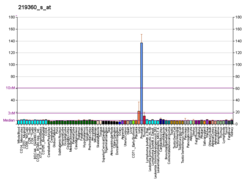| TRPM4 |
|---|
|
| Identifiers |
|---|
| Aliases | TRPM4, PFHB1B, TRPM4B, LTrpC4, htransient receptor potential cation channel subfamily M member 4, EKVP6 |
|---|
| External IDs | OMIM: 606936; MGI: 1915917; HomoloGene: 23033; GeneCards: TRPM4; OMA:TRPM4 - orthologs |
|---|
| Gene location (Human) |
|---|
 | | Chr. | Chromosome 19 (human)[1] |
|---|
| | Band | 19q13.33 | Start | 49,157,741 bp[1] |
|---|
| End | 49,211,836 bp[1] |
|---|
|
| Gene location (Mouse) |
|---|
 | | Chr. | Chromosome 7 (mouse)[2] |
|---|
| | Band | 7|7 B3 | Start | 44,952,056 bp[2] |
|---|
| End | 44,983,204 bp[2] |
|---|
|
| RNA expression pattern |
|---|
| Bgee | | Human | Mouse (ortholog) |
|---|
| Top expressed in | - rectum
- minor salivary glands
- right uterine tube
- skin of abdomen
- gallbladder
- left lobe of thyroid gland
- right lobe of thyroid gland
- ascending aorta
- body of stomach
- right coronary artery
|
| | Top expressed in | - jejunum
- duodenum
- colon
- ileum
- lip
- left colon
- stomach
- esophagus
- internal carotid artery
- epithelium of stomach
|
| | More reference expression data |
|
|---|
| BioGPS |  | | More reference expression data |
|
|---|
|
| Gene ontology |
|---|
| Molecular function | - nucleotide binding
- calcium channel activity
- calmodulin binding
- ion channel activity
- ATP binding
- sodium channel activity
- calcium activated cation channel activity
- calcium ion binding
- metal ion binding
| | Cellular component | - integral component of membrane
- Golgi apparatus
- membrane
- plasma membrane
- nucleoplasm
- endoplasmic reticulum
- cytosol
- neuronal cell body
- sodium channel complex
- spanning component of plasma membrane
- spanning component of membrane
| | Biological process | - adaptive immune response
- vasoconstriction
- immune system process
- positive regulation of canonical Wnt signaling pathway
- regulation of membrane potential
- cation transport
- ion transport
- protein sumoylation
- dendritic cell chemotaxis
- regulation of T cell cytokine production
- cardiac conduction
- positive regulation of cell population proliferation
- calcium ion transport
- negative regulation of bone mineralization
- positive regulation of atrial cardiac muscle cell action potential
- positive regulation of heart rate
- transmembrane transport
- positive regulation of adipose tissue development
- positive regulation of cytosolic calcium ion concentration
- calcium ion transmembrane transport
- positive regulation of fat cell differentiation
- positive regulation of insulin secretion involved in cellular response to glucose stimulus
- negative regulation of osteoblast differentiation
- positive regulation of vasoconstriction
- positive regulation of regulation of vascular associated smooth muscle cell membrane depolarization
- ion transmembrane transport
- calcium-mediated signaling
- membrane depolarization during AV node cell action potential
- membrane depolarization during Purkinje myocyte cell action potential
- membrane depolarization during bundle of His cell action potential
- regulation of heart rate by cardiac conduction
- sodium ion import across plasma membrane
- regulation of ventricular cardiac muscle cell action potential
- protein homotetramerization
- cellular response to ATP
- inorganic cation transmembrane transport
| | Sources:Amigo / QuickGO |
|
| Orthologs |
|---|
| Species | Human | Mouse |
|---|
| Entrez | | |
|---|
| Ensembl | | |
|---|
| UniProt | | |
|---|
| RefSeq (mRNA) | NM_001195227
NM_017636
NM_001321281
NM_001321282
NM_001321283
|
|---|
NM_001321285 |
| |
|---|
| RefSeq (protein) | NP_001182156
NP_001308210
NP_001308211
NP_001308212
NP_001308214
|
|---|
NP_060106 |
| |
|---|
| Location (UCSC) | Chr 19: 49.16 – 49.21 Mb | Chr 7: 44.95 – 44.98 Mb |
|---|
| PubMed search | [3] | [4] |
|---|
|
| Wikidata |
| View/Edit Human | View/Edit Mouse |
|



















